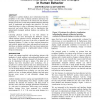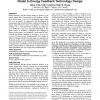5054 search results - page 23 / 1011 » How designers design and program interactive behaviors |
101
click to vote
PUC
2010
14 years 10 months ago
2010
This paper describes three design values that we apply for designing playful interactions. Interactive play objects can stimulate social interaction and physical play by providing ...
91
Voted
PERVASIVE
2007
Springer
15 years 5 months ago
2007
Springer
Peripheral or ambient displays move information from the periphery to the center of human attention and back. Our research group is interested in the interaction and interface des...
85
Voted
CHI
2010
ACM
15 years 6 months ago
2010
ACM
Global warming, and the climate change it induces, is an urgent global issue. One remedy to this problem, and the focus of this paper, is to motivate sustainable energy usage beha...
IROS
2009
IEEE
15 years 6 months ago
2009
IEEE
— Autonomous underwater vehicles (AUVs) are an indispensable tool for marine scientists to study the world’s oceans. The Slocum glider is a buoyancy driven AUV designed for mis...
ATAL
2007
Springer
15 years 3 months ago
2007
Springer
Interactions between agents in an open system such as the Internet require a significant degree of flexibility. A crucial aspect of the development of such methods is the notion o...


